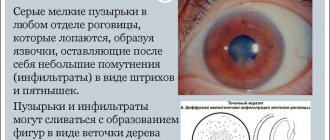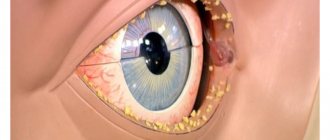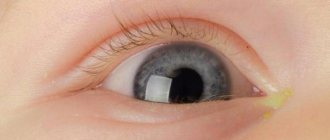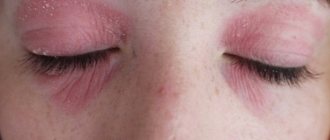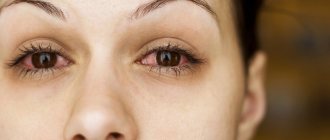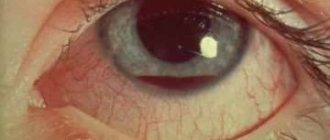The list of the most common diseases of the organs of vision includes conjunctivitis, namely its purulent form. This disease can occur in isolation, but often it occurs as a secondary complication of an already present pathology (streptococcal tonsillitis, scarlet fever and many other infections). Purulent conjunctivitis is extremely contagious and is more common in children, but often occurs in adults.
It develops mainly due to bacterial diseases, and some types of pathogens lead to a particularly severe course of the disease, including blindness. Therefore, you need to take it seriously, and at the first manifestations, go to the doctor for help.
Causes
The main reason for the development of such conjunctivitis in adults and children is infection with harmful bacteria. It is important to consider that self-medication or lack of therapy complicates the course of the disease. It does not go away on its own and requires complex treatment. In this case, recovery will occur much earlier and without complications. The causative agents of this type of pathology are the following microorganisms:
- staphylococci;
- streptococci;
- pneumococci
They end up in the conjunctiva due to poor hygiene. This often happens when a person touches their eyes with dirty hands. You can also become infected through another person's household items: towels and underwear. There is also a risk if you are constantly in a highly polluted environment.
An adult may also encounter the disease if chlamydia and gonorrhea pathogens are observed in the body. It is very easy to get infected with such diseases. Not only contact with an infected person is enough. Also through his personal household items. There is a particular risk of infection during unprotected sexual intercourse.
Features of treatment in children
In children, purulent conjunctivitis occurs much more often than in adults. Children constantly touch their eyes with dirty hands and rub them, so it is very easy for germs to penetrate the conjunctiva. In addition, the child’s body has a weak immune system, which creates an even greater risk for the development of purulent conjunctivitis.
Treatment of the disease in childhood is not much different from in adults. The drugs used are similar, but when treating children, stages and a gentle regimen are needed.
How to wash a child’s eyes if purulent discharge bothers him greatly? The outer part of the eyes is wiped with a cotton swab dipped in a slightly pink solution of potassium permanganate. Eye treatment for purulent conjunctivitis in children is carried out after sleep. This will help get rid of dried purulent crusts.
Then the conjunctival sacs are washed using a medical bulb or a syringe without a needle. All this must be done in the morning, and if necessary, the child’s purulent eyes (after agreement with the doctor) are washed several times a day.
After washing, instillation of medicinal drops is made, which were prescribed by the doctor, taking into account the determination of the sensitivity of the microflora. It is enough to inject one drop of medicine into the conjunctival sac. If you drip more, the medicine will simply flow out of the eye.
During the acute period of the disease, instillations are carried out every hour. The fact is that tear fluid quickly washes the medicinal drug out of the eyes, sometimes it simply does not have time to exert its healing effect. In this case, there is a high probability of the disease progressing to the chronic stage. There is no need to be afraid of an overdose; the drops have a local effect, not a systemic one.
At night, antibacterial ointments are placed behind the baby's eyelid. After eliminating the symptoms of the acute phase of the disease, instillations are reduced to 6 times a day. Treatment lasts 3-5 days so that the inflammation does not become chronic.
Risk group
There is always a risk of becoming infected with pathogenic microflora. Especially if hygiene rules are not followed. Predisposing factors that provoke the development of this type of conjunctivitis:
- hypothermia;
- mechanical damage;
- damage to the visual organs by a foreign body;
- frequent stress and depression;
- chemical and other burns;
- dry eye syndrome.
If a person wears and cares for contact lenses incorrectly, he may also experience this disease. In children it may appear in the first month after birth. Parents must provide proper care for the child. Bed linen must be ironed after washing.
Diagnostic features
Before starting treatment, in each case, the ophthalmologist must perform a diagnosis to identify the type of conjunctivitis, due to which the appropriate treatment will be prescribed. The diagnostic kit consists of:
- Analysis of complaints and manifestations of the inflammatory process, which the patient should tell about;
- Questioning about possible causes of infection (for example, contact with an infected person);
- Examination of the eyelids, conjunctiva and eyeball;
- Biomicroscopy;
- Bacteriological examination of a smear;
- Installation test;
- Enzyme immunoassay;
- Cytological examination;
- Detection of allergic reactions.
To make an accurate diagnosis, you may additionally need to consult with an allergist, dermatovenerologist or phthisiatrician.
Classification
The main types of the disease are classified based on the causative agent of conjunctivitis:
- Gonococcal. In adults, it is transmitted sexually.
- Staphylococcal. Transmitted by airborne droplets.
- Chlamydia. A severe and dangerous form of the disease. Caused by bacteria that enter the body during unprotected sexual intercourse and poor hygiene.
- Pseudomonas aeruginosa. Develops in the presence of Pseudomonas aeruginosa. A person can become infected if they violate personal hygiene rules.
It is important to consider that gonococcal conjunctivitis is very dangerous to health. Every person has staphylococci and streptococci in their microflora. When the immune system is weakened due to injury, such bacteria begin to actively develop. Against this background, a certain form of conjunctivitis develops. The disease can develop independently in older people. Predisposing factors may be a cold or hypothermia.
Considering the degree of development of such conjunctivitis, in ophthalmology it is divided into the following types:
- catarrhal – symptoms appear in a mild form, the initial stage of the disease;
- filmy - in this case the eyes are closed with a film, and an aggravation of all symptoms is observed;
- follicular – accompanied by the appearance of characteristic follicles and ulcers.
It is worth considering that follicular conjunctivitis is a dangerous and advanced form of the disease. Treatment is long and complex. Without treatment, severe complications may develop. The disease is also acute and chronic.
Types of disease
Conjunctivitis can take any form, everything will depend on the method of infection and the type of bacteria developing, so each case will be unique and require special treatment.
Staphylococcal
Staphylococcal conjunctivitis is an acute or chronic inflammation of the conjunctiva, which is caused by bacteria of the Micrococcae family: S. aureus and S. epidermidis. Symptoms of this disease begin to appear 1-2 days after infection and are accompanied by copious discharge of pus, mucus, as well as the formation of crusts of pus on the eyelids. In addition, the patient is constantly bothered by itching, burning and the sensation of the presence of a foreign object in the eye.
Most often, one eye is affected first, and after 2-3 days the second one is affected. Germs are introduced with the help of dirty hands, because the slightest contact with the eye is enough, and the germs already begin to actively develop.
If treated incorrectly or untimely, staphylococcal conjunctivitis causes diseases of the nasopharynx, skin, as well as otitis media, sinusitis, damage to the lacrimal ducts and dry eye syndrome.
Gonococcal
Gonococcal conjunctivitis is considered one of the most dangerous (the causative agent is Neisseria gonorrhoeae), especially for newborns. Most often, they become infected with it during birth, when passing through the birth canal of a mother suffering from gonorrhea or through care items, and if treatment is not started in time, the child can go blind.
Expert opinion
Danilova Elena Fedorovna
Ophthalmologist of the highest qualification category, Doctor of Medical Sciences. Has extensive experience in diagnosing and treating eye diseases in adults and children.
The disease begins to develop on the 2nd or 3rd day after birth and is accompanied by bluish swelling of the eyelids, which become severely swollen, to the point that the eyes are practically invisible. A large amount of pus is released from the conjunctiva, which has a bloody-burgundy tint; after 4-5 days, the eyelids become soft, and the pus begins to be released in even larger quantities, but with a more liquid yellow consistency.
Gonoblenorrhea causes the greatest danger when the cornea is damaged, that is, swollen eyelids and irritated conjunctiva compress it to such a state that further nutrition is considered almost impossible, and it becomes dull.
Against the background of all this, a gray-yellow infiltrate appears, which disintegrates within a short time and turns into an ulcer. The ulcer, in turn, clears, heals and turns into a cataract, and if it was purulent, it usually leads to perforation of the cornea. The infection then gets inside the eye and eventually causes atrophy of the eyeball.
REFERENCE. In adults, gonoblennorrhea is much more severe than in children, as it can cause fever, damage to joints and muscles, and even disruption of the heart. Most often, the disease leads to atrophy of the eyeball and blindness.
Chlamydial
Chlamydial conjunctivitis is intermediate between bacterial and viral, and is caused mainly by gram-negative intracellular bacteria. Such microorganisms are considered independent, have unique ways of development and exhibit the properties of various viruses and microbes.
Symptoms
Clinical manifestations depend on the form of the disease and the degree of damage. The main features are identified:
- profuse purulent discharge from the eyes;
- swelling of varying complexity;
- redness;
- burning, itching;
- sensation of a foreign body in the eyes;
- sensitivity to light.
Considering what microorganisms are the causative agents of the disease, symptoms appear. They can be expressed in different ways. Sometimes discharge may not appear at all. In other cases, they cause the inability to open your eyes in the morning. Discharges are eliminated using medicinal solutions.
Initially, only one eye may be affected. But in most cases, the disease spreads to both eyes within a few days. It is important to consider that symptoms change from the moment of infection. Initially, the discharge has a watery consistency, which becomes more liquid. At the initial stage of development of the disease, the exudate has a white tint, and over time it becomes yellow. During an examination, an ophthalmologist often observes the appearance of erosions on the mucous membrane. Sometimes your body temperature may also increase.
Diagnosis and treatment
To eliminate the disease, you should consult an ophthalmologist, who, before treating purulent conjunctivitis, conducts diagnostics. It begins with collecting an anamnesis. The doctor must find out what signs are present and how quickly the symptoms progress. An examination is performed using a slit lamp.
A scraping is made from the mucous membrane of the eye for subsequent bacterioscopic examination. The doctor uses a special instrument to collect mucous fluid, place it on a sterile glass and send it for laboratory testing.
Bacteriological culture is carried out. Mucopurulent discharge from the eye is placed in a favorable environment to accelerate growth. This is how the bacterial colony is accurately determined.
Treatment must be started as quickly as possible, before the acute form of the disease becomes chronic and complications appear. Uncomplicated forms of purulent conjunctivitis are treated with local remedies. If there are complications, systemic antibacterial therapy is selected.
The standard treatment regimen lasts 7-10 days. During this time, you should not use lenses, decorative cosmetics, or touch your eyes with your hands (for this use clean paper disposable handkerchiefs). It is better to refuse any work associated with eye strain.
Antibacterial solutions are used to wash the eyes every day. These are Rivanol, Levomycetin, as well as antiseptics (weak solution of potassium permanganate). After washing, instillation of drops with an antibacterial effect (Tobrex, Tsipromed, Tobrimed, Floxal, Tsipromed, Okomistin) and antiseptic drops of Oftadek are carried out. To eliminate unpleasant symptoms, drugs such as “artificial tears” are used.
Read in a separate article: What is conjunctivitis: types, signs and how to treat it
Combination agents such as Tobradex, Sofradex can be used. At night, ointments with an antibacterial effect (Floxal, Erythromycin, Tetracycline) are placed behind the eyelids. If a resistant microflora has developed, then the introduction of antibacterial drugs from the fluoroquinolone group (Ofloxacin) will be required.
If the disease is viral in nature, medications with interferon and restorative vitamin complexes are prescribed.
Treatment must be continued until the doctor decides that the disease is completely eliminated. If a person completes treatment on his own without prior approval from a doctor, complications and rapid relapse of the disease may develop, which can lead to decreased vision up to complete blindness.
Treatment
Therapy can be prescribed only after correct diagnosis. The success of treatment depends on this. The main principle of treatment is to take therapeutic measures. The sooner the patient begins treatment, the faster the recovery will occur. If this is not done on time, the pathology can quickly become chronic. Typically, ophthalmologists prescribe complex therapy. The main rule is strict adherence to the rules of personal hygiene.
Drops
For this form of conjunctivitis, the following drops will be effective:
- Albucid;
- Ofloxacin;
- Ciprofloxacin.
Visine can be used to moisturize the mucous membrane. Drops can be alternated with ointments and other medications. It is important to remember that medications can only be taken strictly as prescribed by your doctor.
Solutions
Solutions are used to treat the eyes and eliminate exudate in the morning after a night's sleep. It glues the eyes together, and the person simply cannot open them. To do this, you will need a cotton swab and a weak solution of potassium permanganate. It dries out the mucous membrane well and helps get rid of purulent discharge.
Douching is carried out using a syringe. It is worth considering that the syringe must be without a needle. After this, drops and ointments based on antibiotics are used. Additionally, you can make a chamomile infusion to wash your eyes during the day.
Treatment of purulent conjunctivitis in adults
An integrated approach is needed to treat the disease. Antibacterial drugs (Albucid, Ciprofloxan) must be prescribed. Before applying the ointment to the affected eyelid, treat it with Furacilin solution or chamomile decoction.
To get rid of unpleasant symptoms, purchase Visine or Artificial Tear eye drops; they will moisturize the eyelids and prevent them from sticking together. Do not use tight bandages under any circumstances, you will only make your situation worse!
Immunologist Andrey Prodeus will talk about the treatment of conjunctivitis in the video.
Return to contents
Medication
The main drugs aimed at treating purulent inflammation are Actipol, Albucid, Oftalmoferon. The ointment is placed behind the affected eyelid and left overnight to enhance the antibacterial effect. Treatment is continued until the symptoms of the disease are completely eliminated.
Staphylococci are highly resistant to drugs, so fluoroquinolones (for example, Ofloxacin ointment 0.3%) are used to eliminate conjunctivitis caused by such bacteria. Children should not be given antibacterial drops that contain antibiotics.
How to treat purulent conjunctivitis in adults (the order of therapy should not be violated in any case):
- Every day after waking up, clean your eyes of accumulated pus. A weak solution of potassium permanganate is suitable for these purposes. Soak a swab in it or use a clean syringe without a needle. You need to rinse the affected eye several times during the day when pus appears;
- Every hour (or according to the individual recommendations of the ophthalmologist), instill the drug prescribed by the doctor;
- Before going to bed, place tetracycline ointment in the conjunctival sac.
When the acute stage of the disease has passed, the drops can be instilled six times a day.
ethnoscience
Grandmother's recipes effectively fight purulent conjunctivitis, if it is not advanced.
- Make lotions from chamomile infusion four times a day. To do this, pour a tablespoon of dried flowers into a glass of boiling water and let it brew;
- The most effective and affordable way is lotions made from black or green tea. Brew a weak drink, cool and use for compresses;
- Take fresh dill, wash it well and squeeze out the juice. Then soak gauze or a cotton pad in it and apply it to your eyelids, leave for fifteen minutes. An infusion of greenfinch seeds effectively fights purulent inflammation. To prepare it you will need a glass of boiling water and a teaspoon of dill seeds;
- Rinse your eyes with rosehip decoction. Pour a glass of water over a couple of crushed berries and boil for ten minutes. After the infusion has cooled, it can be used;
- Prepare a mask from raw potatoes. Grate the fruit and combine it with egg white, apply the mixture to the eyelids for fifteen minutes;
- Eye drops can be prepared at home. Combine one part honey with two parts water, mix everything well and bury it. The product is also suitable for compresses; store the composition in the refrigerator;
- Lubricate your eyelids, wash your eyes, prepare lotions and drink - all this can be done with plant juices. Juice made from parsley and carrots in a ratio of 1:3 works well for purulent conjunctivitis. Drink it three times a day, one hundred grams before meals.
| Remember that all traditional medicine recipes can be used only after consultation with the doctor. |
Complications
The main complication is that the disease can become chronic. This usually happens in the absence of proper and timely treatment. Follicular and chlamydial conjunctivitis are dangerous. They can cause irreversible processes and significantly impair vision.
Mucopurulent conjunctivitis can occur at any age. In children it can have an acute or chronic form. In newborns, it causes a restless state of the baby. He cannot sleep at night, and in the morning he cries a lot because he cannot open his eyes.
Possible consequences and complications
If you choose the wrong type of therapy or consult a doctor too late, purulent conjunctivitis can cause serious complications:
- Accumulation of pus in the anterior chamber of the eye;
- Development of chronic blepharitis;
- Lens loss;
- Destruction of corneal tissue;
- The appearance of scars on the conjunctiva.
The disease most often affects people with a weakened immune system after suffering a viral or infectious disease (dystrophy, anemia, etc.). In children, the disease can cause progression of keratitis and dacryocystitis.
Prevention
It is very important to follow the rules of prevention that will help reduce the risk of developing such a form of conjunctivitis. But they must be observed constantly. Therefore, doctors recommend:
- Always strictly adhere to hygiene rules. It is strictly forbidden to use towels, linen, or household items of another person.
- Follow safety rules in factories and heavily polluted areas. It is necessary to wear a protective mask and goggles.
- Use high quality cosmetics.
- In any situation, do not touch your eyes with dirty hands.
- Avoid contact with an infected person.
- See a doctor in a timely manner and do not self-medicate.
- Lead a healthy lifestyle, include foods rich in vitamins and beneficial microelements in your diet.
The basic rule of prevention is compliance with the rules of personal hygiene. Particular attention should be paid to intimate life. Often, infection with chlamydia and gonorrhea pathogens is transmitted sexually. Such pathogenic microorganisms lead to the development of severe conjunctivitis. With timely treatment, the patient can count on a favorable result.
Folk remedies for treatment
If a doctor has detected conjunctivitis in a patient, the use of folk remedies for treatment is allowed only with his permission, and then as an additional therapy.
Cleaning products
To quickly get rid of conjunctivitis, it is important to constantly wash your eyes with the solutions listed above. But for this, you can also use some solutions from traditional medicine:
- Freshly brewed and chilled tea leaves.
- Tincture of agave and honey.
- Water tincture with plantain leaves.
- Chamomile tincture.
- Aloe juice diluted with water.
Treatment with compresses
When treating eye inflammation with herbs, experts advise applying healing compresses and lotions.
- A potato-based compress, which is prepared with potatoes ground in a blender. The resulting pulp is wrapped in several balls of bandage and applied to the eyelids for 10-15 minutes.
- Aloe tincture - you can use the root or flowers.
- Tincture of plantain seeds - pour 2 tablespoons of seeds into a glass and pour 100 milliliters of boiling water. The cooled infusion is filtered, soaked in gauze and applied to the eyelids.
- Water with honey - to eliminate the symptoms of conjunctivitis, you can dilute bee honey with heated boiled water (1 to 2). Tampons are soaked in the liquid and applied to the eyelids for 5-10 minutes.
What is a disease?
Acute purulent conjunctivitis is an inflammation of the mucous membrane lining the whites and inner surface of the eyelids. Pus indicates that the nature of the inflammation is a bacterial infection. It is bacteria that actively multiply and cause pus to appear.
There are different forms of conjunctivitis:
- bacterial;
- viral;
- allergic.
Purulent and mucopurulent conjunctivitis is always bacterial. In this case, inflammation of the conjunctiva and cornea is always accompanied by the release of a certain amount of purulent discharge.
It is classified according to the pathogen:
- Staphylococcal. Caused by a common bacteria called staphylococcus. Transmitted by contact: bacteria are introduced into the eyes when they are touched with dirty hands or through personal hygiene products.
- Gonococcal. Gonococcus is transmitted sexually. This form of conjunctivitis is more common in newborns, who become infected while passing through the birth canal of an infected mother. Contact transmission in adults is also possible, but it happens less frequently.
- Pseudomonas aeruginosa. Caused by Pseudomonas aeruginosa, which is transmitted by contact, for example when a person does not follow hygiene rules when using contact lenses.
- Chlamydial. Chlamydia also causes severe purulent inflammation if it gets on the mucous membrane of the organs of vision. May affect newborns similarly to gonococcal conjunctivitis, for the same reason.
Depending on the specific pathogen, the symptoms of purulent conjunctivitis, prescribed medications, and the regimen for their use may vary.
Read more about the treatment and diagnosis of the purulent form in children here.
Symptoms of conjunctivitis
The characteristic symptoms of conjunctivitis depend on the nature of the disease.
However, all types of conjunctivitis have certain common signs and manifestations. Thus, regardless of the genesis, swelling and discoloration of the mucous membranes, itching and uncontrolled tearing, blepharospasm, and photophobia develop; pus or mucus is secreted. One of the main symptoms is the sticking of the eyelids with dried secretions.
The development of adenoviral and ulcerative keratitis provokes decreased vision. The process is bilateral in nature, it can affect one organ and move on to the second with varying degrees of severity.
Acute form
manifests itself with the immediate development of pain and pain in the eyes. The capillaries expand, the thinned and stretched walls cannot withstand the pressure of blood, and hemorrhages occur.
Acute conjunctivitis is characterized by significant swelling and chemosis of the mucous membrane. At the beginning of the disease, pronounced conjunctival injection is observed. Without proper treatment, the deep layers of the cornea are affected, and pericorneal injection develops. Discharge – copious, mucous, purulent or mixed. Associated symptoms are weakness, malaise, low-grade fever. Inflammation lasts from seven days to a month.
Clinic of subacute conjunctival process
less pronounced. Symptoms gain strength gradually, the course is slow, but long-lasting and persistent. With moderate redness and looseness of the mucous membrane, rapid fatigue, discomfort and a feeling of clogged eyes are noted.
The only specific sign of bacterial
conjunctivitis - separation of pus and mucus of a yellowish or greenish color. In terms of volume, the released substance can be both abundant and barely noticeable. The discharge is initially watery, but within 24 hours it becomes mucous, purulent or mixed. Pain and pain in the eyes, dryness of the eyelids and surrounding areas, and the formation of areas of hemorrhage and necrosis are also possible.
A common symptom of all types of viral
conjunctivitis - profuse uncontrollable tearing and severe redness of the sclera. The clinical pictures of herpetic and adenoviral conjunctivitis are different, which makes it possible to accurately differentiate them before taking diagnostic measures. A characteristic sign of viral conjunctivitis is the formation of vesicles (follicles) or films (pseudomembranes) on the conjunctiva. Associated symptoms are blepharospasm, photophobia, enlarged regional lymph nodes.
Allergic
Conjunctival lesions develop within a period of several minutes to two days. It has a bilateral course, accompanied by severe itching, cough and runny nose, swelling, redness of the sclera and eyelids, ptosis and lacrimation. In severe cases, the cornea, retina, and blood vessels are affected. The acute form, caused by uncontrolled use of drugs, is accompanied by urticaria, Quincke's edema, and anaphylactic shock.
Clinical picture of fungal
conjunctivitis depends on the type of parasitic fungus. Thus, actinomycosis is characterized by the development of purulent or catarrhal-diffuse conjunctivitis; Large pink-yellow formations appear on the inside of the eyelids. With sporotrichiasis, the pathology also affects the sclera; may proceed easily, without exudate, or may develop into an ulcerative process with the formation of red-violet ulcerations. A sign of blastomycosis is the appearance of thin, small, whitish, gray or yellowish films. When they are removed, reddened, erosive mucosa is visible. With candidomycosis, lymphoid and epithelial tissue grows and nodules form. Common manifestations of aspergillosis are damage to the cornea and changes in the structure of the mucosa with dilated capillaries.
At toxic
conjunctivitis, any blinking of the eyes, attempts to open and close them are accompanied by severe, sometimes unbearable pain.
Prevention of inflammation
All methods of preventing purulent conjunctivitis are combined into one general principle: observe the rules of personal hygiene:
- use only personal hygiene products;
- wash your hands thoroughly;
- never touch your eyes with unwashed hands;
- Those who use contact lenses should use special solutions to clean them, and never remove or put on lenses without washing their hands.
Preventing a disease is always easier than treating it, so do not neglect these simple rules.
Purulent conjunctivitis is an acute inflammatory eye disease caused by bacteria. With timely treatment with local antibiotics, this unpleasant disease is not dangerous and goes away without a trace in a few days.
Additionally, we invite you to watch a video about treatment and first aid for conjunctivitis, prevention, where the attention of an ophthalmologist is focused on the bacterial, purulent form:
Share the secrets of your treatment and experience in the comments. Bookmark the article so as not to lose it and repost it on social networks. All the best.
Types and causes of appearance
Purulent conjunctivitis is divided into three groups and occurs:
- gonococcal;
- staphylococcal;
- Pseudomonas aeruginosa.
The first gonococcal type is most often diagnosed in newborns; severe symptoms appear almost immediately after birth. The cause of infection is passage through the birth canal infected with the gonorrhea pathogen. The gonococcal form is one of the most dangerous because it can cause severe damage to the cornea and, if untreated, causes complete blindness.
Gonococcal conjunctivitis is potentially very dangerous. Even after complete healing, small scars remain in most cases on the conjunctival membrane.
Infection with the pathology of the staphylococcal form occurs through contact - that is, through personal hygiene products, handshakes, and so on. The main precaution in this case is compliance with the rules of visual hygiene. Pseudomonas aeruginosa infection enters the eye through microtraumatic injuries as a result of improper use of contact lenses (how to wear contact lenses correctly is described here). This form rarely spreads to the second eye, although this possibility cannot be excluded. The main symptoms are lacrimation, discharge, fear of light, general irritation, corneal erosion. If you do nothing, the process can be started and keratitis will appear. After ulcerations heal, scars almost always form.
Very often, infection with purulent conjunctivitis occurs due to the fact that a person rubs his eyes with dirty hands.
Either two eyes or one can suffer. If both are affected, it happens simultaneously or with an interval of one to three days. The method of infection is almost always contact - that is, from an infected person or animal to a healthy one. Domestic dogs and cats can also be carriers of infections. At risk are people with poor immunity, to whom any infection clings very quickly.




